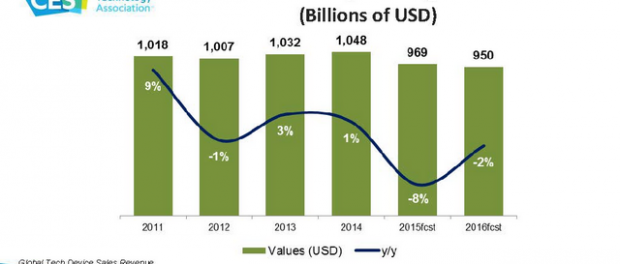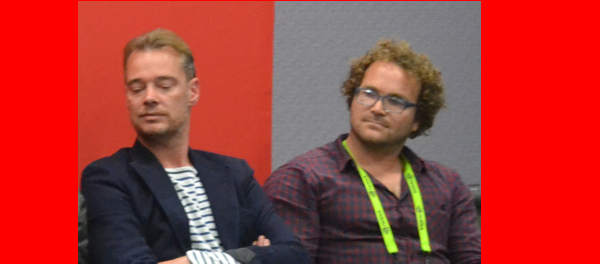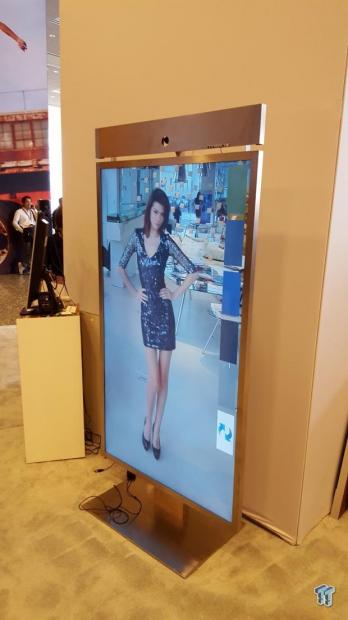
by Lidia Paulinska | Jan 27, 2016
January, CES 2016 – At the press event on January 4, Steve Koenig, Senior Director, Market Research presented Technology World Tour. Every year GfK and CTA announced Global Consumer Technology Spending Forecasts based on statistics from more than 340,000 retail stores in 80 countries. The analysis consider the geographical and financial aspects in electronics industry with separate numbers for mature (North America, Western Europe and developed APAC) and developing (Central/Eastern Europe, latin America, Emerging APAC, Middle East/Africa) markets.
How the Global Market 2016 looks like? Are Global technology spending on track?


Steve Koenig mentioned few reasons responsible for declining spending: Strong Dollar, that is unfavorable to conversion of global currencies; ASPs trending lower in categories with big impact such as smartphones (-7%), TV (-2%) and laptops (-4%); Global unit growth is moderate or negative in key sectors such as TV (1%), smartphones (8%), laptops (-3%) and tablets (-8%); Economic weakness in several emerging markets such as Latin America and Central/Eastern Europe; finally the China slowdown, the country is transitioning to consumption/services that has spillover effect on commodity dependent economies.
In the Global Tech Industry the new/nascent categories are playing bigger role in global growth. They are Smart Home, Virtual and Augmented Reality (VR/AR), Drones, 3D Printing, Digital Health Devices, Automotive and Robotics.
Steve Koenig, who like to refer the 7 best tech categories (tablets, laptops, cellphones, TV, smartphones, desktops and cameras) as Magnificent Seven presented their strength for 2016 versus the last year. It seems like they are losing their impact. In 2015 their revenue share was 79%, reaching $761 billion. It 2016 it is 78% and $740 million accordingly.

According to Koenig, the Global Sales by Product similar like in 2014 and 2015, remains mixed in 2016.


by Lidia Paulinska | Sep 1, 2015
August 2015, Siggraph – Two panelists came from Amsterdam to attend Siggraph 2015 and at the Lenovo’s panel share discussion about their new project. Tim Geurtjens and Gijs Van Der Velden are co-founders of MX3D, a company researching and developing groundbreaking robotic 3D printing technology. They developed 3D large scale printers that allowed printing large structures and different materials including plastic, stainless steel and aluminum. Tim and Gijs recently came up with an ambitious plan to build a steel bridge over the canal in Amsterdam. Geurtjens confessed that idea of building a bridge using 3-D printing techniques started with frustration about the 3D printing market. “We use 3D printers all the time, but they make only the small parts. We asked the companies that manufacture 3-D printers to develop printers for large parts but the companies were not interested in developing them” said Guertjens, “so we decided to do it on our own.”
Tim and Gijs discussed their plan to build a 3D printed steel bridge over the canal in Amsterdam. “We want to show the world what that technique could do”. The founders of MX3D are getting government support for this project as the city officials are really interested in presenting Amsterdam as an innovative and progressive city. Even though they invented the technology, they estimate that it will take them a year to understand fully, the capacity and the limits of their technology in an outdoor application and do a design. The starting date is set for spring 2017 and with an estimate to take 3-4 months to print the bridge. The most interesting thing about this 3-D image technique is that we can not only print the building as a new object, but we can use the multi-robots in the system to build in place from an existing structure. In that case, the projects can be of unlimited size” said Geutjens.
Using these 3D printing techniques, it is possible to recreate things. Geurtjens sees the printers as an extension of the existing techniques. Currently, there is a Chinese company that is us using additive manufacturing to print buildings, but it is more efficient and most appreciated, if we use the technology to create additional decorative pieces. It is well known that decoration is the heart of architecture. The use of computers and printers allows these designs to be extravagant, as it does not matter how complex the pieces are. Why use traditional techniques if we can add to them with the time and money consuming details?

by Lidia Paulinska | Aug 21, 2015
August 2015 – One of the major announcements at this year’s IDF was the availability and applications of the Realsense stereo 3D camera system in modules, tablets, and laptops. The technology was featured in a large section of the conference area and the display areas.
Targeting consumer applications, they were showing off the speed and accuracy of the technology with a couple of different exhibits. One was a 3D printing demonstration. It featured taking a 360 degree Stereo 3D photo of a person’s head, and then in real time transferring it to a 3D laser printer. The printer carved the image into a block of Lucite and producing an embedded 3D likeness of the person. The demonstration was so popular that they had to go to rotating time and call back system to get the images taken and printed. While the image capture is fast, under a couple of minutes, the laser printer averages about 20-25min per print which is what caused the queue for the demo.
One of the other heavily attended demo was a mirror with the integrated RealSense camera. The camera would take a 3D image of the person in front of the mirror. The mirror is actually a half mirrored display that can then superimpose jewelry on the person in the mirror. The system allows for the selection of earrings and necklaces on the people in the mirror. This system was very quick on setup – under 1 minute and very responsive to movement. The system is a prototype and had some challenges if there was more than 1 person in the view of the camera, but on the whole it worked well.
There were a number of other RealSense applications targeted at consumers being shown highlighting the measurement capabilities, depth & relative location capabilities, and virtual showroom/furniture capabilities. These have been shown in prior shows, and second generation software was the main display for these technology applications.






